ATP has written in the past about the QINGQI and about rickshaw drivers; it is now time to do an indepth analysis of the Pakistani motor rickshaw.
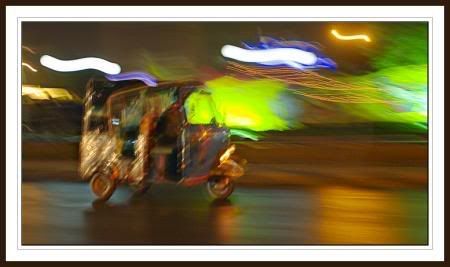
The motor- (sometimes auto-) rickshaw was invented by the Reverend Jonathan Scobie, an American Baptist minister living in Yokohama, Japan. The first model was built in 1869 in order to transport his handicapped wife. Today it remains as one of the most important modes of transportation in Pakistan where it was first seen on August 14, 1947. Before that it was not possible to see it in Pakistan.
 The three- wheel- design of a rickshaw provides it a better road grip than a bicycle. It also provides gasoline savings when compared with a 4-wheeler taxi and green salad saving when compared with a 4-legged horse. When in need of repairs, the three-wheel structure also helps in lifting it from any side. When a side is lifted, it conveniently sits down on the other two while a mechanic goes looking for underbelly mechanical faults.
The three- wheel- design of a rickshaw provides it a better road grip than a bicycle. It also provides gasoline savings when compared with a 4-wheeler taxi and green salad saving when compared with a 4-legged horse. When in need of repairs, the three-wheel structure also helps in lifting it from any side. When a side is lifted, it conveniently sits down on the other two while a mechanic goes looking for underbelly mechanical faults.
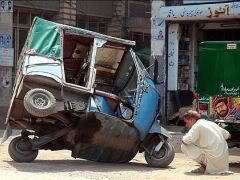
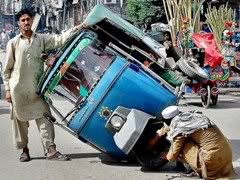
Pilot seat:
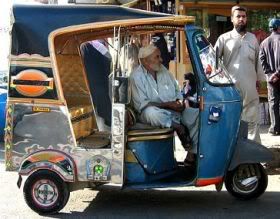 A rickshaw is a perfect example of a compact automobile design. The driver practically sits on a bench seat which is strategically placed on top of the engine. This causes inductive heat transfer between man and machine and keeps the engine cool. The same however, cannot be said for the driver’s butt. The presence of a hot engine underneath, keeps a driver cozy during winters and boiling during summers. It is literally one heck of a hot seat to sit on. The advantage of a bench seat is manifold. A driver uses it to his own advantage to slide from one corner to the other depending on whichever side gives him a better view.
A rickshaw is a perfect example of a compact automobile design. The driver practically sits on a bench seat which is strategically placed on top of the engine. This causes inductive heat transfer between man and machine and keeps the engine cool. The same however, cannot be said for the driver’s butt. The presence of a hot engine underneath, keeps a driver cozy during winters and boiling during summers. It is literally one heck of a hot seat to sit on. The advantage of a bench seat is manifold. A driver uses it to his own advantage to slide from one corner to the other depending on whichever side gives him a better view.
Driver’s Ergonomics.
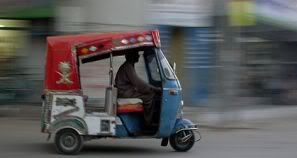 A rickshaw is immaculately designed to keep a driver relaxed during long hours. This has been accomplished by limiting the driving controls to both hands and a leg only. This keeps one leg of the driver free which he can dangle around when tired. Many of us must have seen the common practice where a tired driver lifts one of his legs and conveniently places it on top of the dash-board while still driving the rickshaw.
A rickshaw is immaculately designed to keep a driver relaxed during long hours. This has been accomplished by limiting the driving controls to both hands and a leg only. This keeps one leg of the driver free which he can dangle around when tired. Many of us must have seen the common practice where a tired driver lifts one of his legs and conveniently places it on top of the dash-board while still driving the rickshaw.
Rickshaw Starting Mechanism:
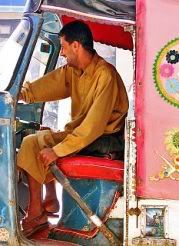 The height of automotive engineering is the design of rod (danda) start mechanism of the rickshaw engine. A 3 feet long lever is put on the floor of the rickshaw. To start the engine, a driver bends down to the side and lifts one end of this ‘danda’ in a quick swift motion. Look at the photo to the right. If everything else is right then the engine starts. Otherwise the whole exercise of ‘danda’ lifting is repeated as many times as needed.
The height of automotive engineering is the design of rod (danda) start mechanism of the rickshaw engine. A 3 feet long lever is put on the floor of the rickshaw. To start the engine, a driver bends down to the side and lifts one end of this ‘danda’ in a quick swift motion. Look at the photo to the right. If everything else is right then the engine starts. Otherwise the whole exercise of ‘danda’ lifting is repeated as many times as needed.
Passengers Foot-hold.
While a rickshaw floor’s mean height above sea level is less than 2 feet, a one-step foot hold is nonetheless provided on the passenger side of the cabin. I’ve never seen anyone using it but it is a detail important enough not to be missed out in this analysis. Most of the passengers bypass this one-step climbing assistance and put their first step directly inside the passenger cabin.
Head lamp.
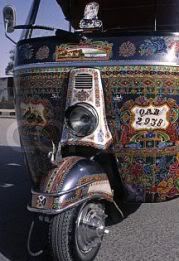 Rickshaw comes with a single headlamp. The light emanating from this headlamp is usually just enough that other people can see that something is on-coming but a rickshaw driver doesn’t see anything. Its luminescence makes one constantly reminded of Elton John’s song ‘candle in the wind’
Rickshaw comes with a single headlamp. The light emanating from this headlamp is usually just enough that other people can see that something is on-coming but a rickshaw driver doesn’t see anything. Its luminescence makes one constantly reminded of Elton John’s song ‘candle in the wind’
Laws of Reflection.
A rickshaw driver usually adorns his rickshaw with a multiple array of reflective mirrors.
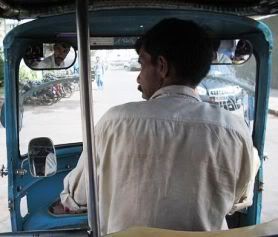 If a ray of light enters a rickshaw once, it gets trapped and it takes a while for it to get out after being internally reflected many times. These mirrors are placed by the driver to his own strategic advantage. If a passenger is to his liking then these mirrors help the driver to keep an eye on the passenger from many different angles.
If a ray of light enters a rickshaw once, it gets trapped and it takes a while for it to get out after being internally reflected many times. These mirrors are placed by the driver to his own strategic advantage. If a passenger is to his liking then these mirrors help the driver to keep an eye on the passenger from many different angles.
Small is Big.
I have never seen a group of people denied a rickshaw ride just because of their numbers. It can fit them all including luggage.
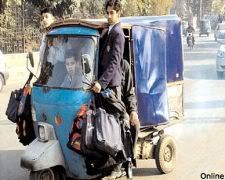
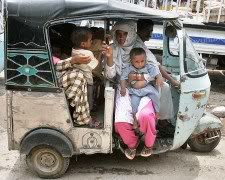
Many times one can see a family chilling out in the passenger cabin while their younger ones sharing driver’s cabin with the driver. If a rickshaw picks up passengers from a railway station, luggage is easily placed in driver’s cabin.
Flat Tire Replacement.
In case of a flat tire adversity, a rickshaw comes fully equipped with a mechanical jack. This jack is in the shape of a rectangular sheet-metal of roughly 12″x 24″ dimension. The simplicity of design here beats all modern hydraulic and geared jack designs. A rickshaw driver simply tilts his rickshaw on a side, inserts this sheet metal plate for support and changes the tire. The whole process of tilting a rickshaw and inserting the jack takes less than 10 seconds.
Where is Rickshaw’s Center of Gravity?
The correct answer is, where ever the rickshaw driver wants it to be. The greatness of Rickshaw design lies in defying the geometrical axioms.
The Amphibian Rickshaws
I guess, I’ll let the following photos speak for themselves.

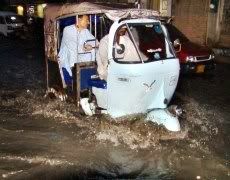

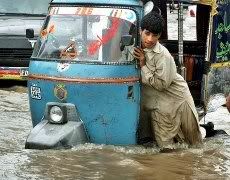
Our Food Supply Depends on Rickshaw Transportation
Following photos say it all. In the photo to the right, a person even has his bare foot dug in Chicken meat.
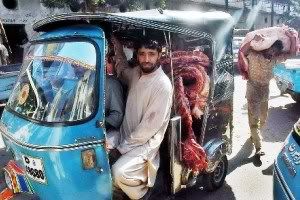
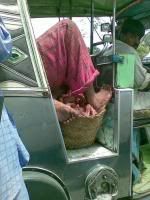
Rickshaw As a Place to Rest
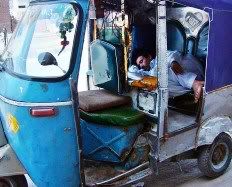
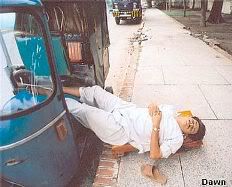
The Rickshaw Driver Culture.
Over the years certain etiquettes have evolved among rickshaw drivers. A passenger cannot just walk into an empty rickshaw and sit. He/She has to take driver’s permission first. The magic question to ask is “Is rickshaw empty?” (rickshaw khali hai?). This question must be asked even if a rickshaw is visibly empty because depending on his mood a driver at anytime may declare a visibly empty rickshaw as occupied. Then there is no question of arguing. Rickshaw drivers have also mastered the sign language. If a rickshaw is empty then instead of saying ‘yes’ a driver usually moves his neck towards the passenger cabin in a long swooshing motion. This means rickshaw is empty. Please get in.
The Rickshaw Terminals
Every major city of Pakistan has Rickshaw terminals where these three-wheelers are rested or repaired. Take a look at following four photos.
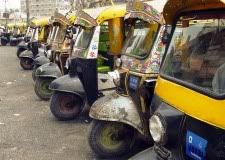
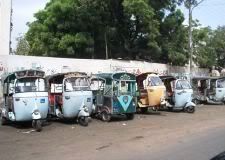
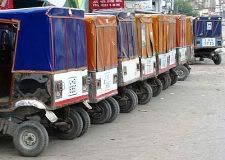
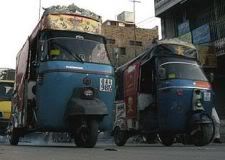
Rickshaw Towing – No Prroblem
When a rickshaw is disabled, towing it to mechanic is no problem. Donkeys, humans and other rickshaws have been traditionally used to tow a sick rickshaw to a mechanic.
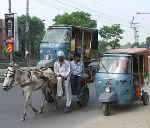


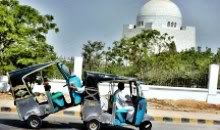
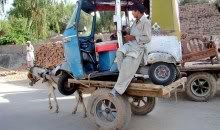
Mirror of Society.
Rickshaws are also a mirror of our society. Rickshaw drivers use back of the rickshaw as their scrap book. It displays their favorite poetry, puzzling questions, messages to other drivers, etc. I don’t remember seeing any rickshaw ever without anything written on its back side. Some of these comments are a running commentary on our society’s social and economic fabric. Take a look at 5 sample rickshaw messages:
mein baRa ho kar Corolla banooN ga
malik ki gaaRi, driver ka paseena
chalti hai road par bun ka haseenakabhi aao na Karachi, khashbo laga ke
Daalar ki talaash
uff baji, rickshaw gayee
Photo Credits: Some photos for this article are courtesy of Mr. Muhammad Ali Musa who is a Quetta based Professional Photographer.
1. Rickshaw for transporting Fresh Chicken meat,
2. Rickshaw as a moving billboard,
3. Rickshaw transporting another Rickshaw,
4. Rickshaw Transporting a bakra (goat), and
5. Rickshaw for transporting People
6. A Virtual Rickshaw Ride
7. CNG Rickshaws in Pakistan



















































Fuel Consumption and Environmental Impact of Cycle Rickshaw Bans in Dhaka
Most trips in Dhaka are short in distance, usually one to five kilometers. These trips are perfect of Rickshaws. Rickshaws are cheap and popular mode of transport over short distances. Rickshaws are safe, environmentally friendly and do not rely on fossil fuels. Rickshaws support a significant portion of the population, not only the pullers, but also their families in the villages, the mechanics who fix the rickshaws, as well as street hawkers who sell them food. From the raw materials to the finished product the Rickshaw employs some 38 different professions. Action needs to be taken to support the Rickshaw instead of further banning it in Dhaka. The combined profits of all Rickshaws out earn all other passenger transport modes (bus, rail, boats and airlines) combined. In Dhaka alone, Rickshaw pullers combine to earn 20 million taka a month.
We think that over the coming holiday of Eid du Ajah, new Rickshaw bans will be put into action on roads in Dhaka. Eid was used in the past to place new bans on roads in Dhaka. Last Eid many roads were declared Rickshaw free without public support or approval. By banning Rickshaws roads are clogged with increased private car use as well as increased parking by cars. Banning of Rickshaws on major roads increases the transportation costs for commuters. Not only due to longer trips to avoid roads with bans in effect, but also due to actually having to take more expensive forms of transport such as CNG or Taxi, where in the past a Rickshaw would suffice. The environmental impact of banning Rickshaws is obvious because it exchanges a non-motorized form of transport for a motorized form of transport, thus increasing the pollution and harming the environment. Rickshaw bans harm the most vulnerable in society, mainly the sick, poor, women, children and the elderly; generally those who can not afford or do not feel comfortable on other forms of public transport. To ban Rickshaws also hurts small businesses that rely on them as a cheap and reliable form of transporting their goods. Rickshaws are ideal for urban settings because they can transport a relatively large number of passengers while taking up a small portion of the road. In 1998 the data showed that Rickshaws took up 38% of road space while transporting 54% of passengers in Dhaka .
The private cars on the other hand, took up 34% of road space while only transporting 9% of the population (1998 DUTP). This data does not include the parking space on roads that cars take up in Dhaka . If included this would further raise the amount of space taken up by private cars. Every year the Rickshaw saves Bangladesh 100 billion taka in environmental damage.
The government makes many efforts to reduce traffic congestion in Dhaka but with no success. Blaming Rickshaws for traffic congestion and subsequently banning them from major roads has not had the desired affect. Traffic is still as bad now as it was before the Rickshaws were banned on major roads. Rickshaws thus can not be seen as the major cause of traffic congestion. Instead one should look towards private cars and private car parking on roads as the major cause of traffic congestion. The space gained by banning Rickshaws is often used for private car parking. The current trend in transport planning reduces the mobility of the majority for the convenience of the minority. The next time a ban on Rickshaws on another road is discussed please take into consideration who is being hurt and who is being helped.
For a better transport system in Dhaka we need to create a city wide network of Rickshaw lanes. If this is done Dhaka can reduce its fuel usage dramatically as well its pollution. We ask your help in our fight to keep Dhaka a Rickshaw city. Any information or help is very much appreciated and sought after. I write you this letter to describe the difficulties we are facing and some solutions but they are by no means exhaustive and we look forward to your help and input.
Volunteer of Save Environment Movement
Email: shovan1209@yahoo.com
Dear Sir/Madam,
Can you send me a list of manufacturers and major/reliable suppliers of rickshaw?
Thanks and kind regards
Dev Naeck
The rickshaw can use for travlling, it is basically use by the poor persons.
Photo of a 4-stroke CNG rickshaw on a Karachi road here
One more rickshaw sher:
kia baat hai ke khat aana bund hai
pyar kam ho gaya ya daak-khaana bund hai
:)